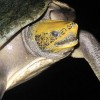 Belize, a country rich in natural resources and diverse wildlife, is home to nine species of freshwater turtles. Among these is the critically endangered hicatee, which has been eliminated in most of its range as a result of hunting and habitat loss. Freshwater turtles live in rivers, creeks, and lagoons, and build their nests on the banks. They eat a variety of plants, aquatic vegetation, and fruits. However, little is known about Belize’s unique turtle species. This 2-page fact sheet will help people identify, understand, and conserve these treasured resources. Written by Venetia Briggs, Lauren Watine, Dustin Smith, Robin Bijlani, Rebecca Harvey, William Giuliano, and Frank Mazzotti, and published by the UF Department of Wildlife Ecology and Conservation, January 2013.
Belize, a country rich in natural resources and diverse wildlife, is home to nine species of freshwater turtles. Among these is the critically endangered hicatee, which has been eliminated in most of its range as a result of hunting and habitat loss. Freshwater turtles live in rivers, creeks, and lagoons, and build their nests on the banks. They eat a variety of plants, aquatic vegetation, and fruits. However, little is known about Belize’s unique turtle species. This 2-page fact sheet will help people identify, understand, and conserve these treasured resources. Written by Venetia Briggs, Lauren Watine, Dustin Smith, Robin Bijlani, Rebecca Harvey, William Giuliano, and Frank Mazzotti, and published by the UF Department of Wildlife Ecology and Conservation, January 2013.
http://edis.ifas.ufl.edu/uw373
Tag: Venetia S. Briggs
Una Guía para Convivir con Felinos Silvestres (WEC316/UW361)
 En Belice, el Centro de Investigaciones de Campo Lamanai (CICL) y la Universidad de la Florida están estudiando los gatos usando trampas-cámaras las cuales se han colocado dentro de varios locales de terrenos privados. Contrario a lo que la gente considera, esta investigación sugiere que existe una mayor cantidad de felinos silvestres habitando cerca de las fincas. This 3-page informational brochure is the Spanish language version of A Guide to Living with Wildcats (WEC314/UW359). It highlights 5 species of wildcats living in the area of the study, tips for keeping livestock safe, and local contacts. Written by Venetia S. Briggs, Rebecca G. Harvey, Frank J. Mazzotti, and William M. Giuliano, and published by the UF Department of Wildlife Ecology and Conservation, October 2011.
En Belice, el Centro de Investigaciones de Campo Lamanai (CICL) y la Universidad de la Florida están estudiando los gatos usando trampas-cámaras las cuales se han colocado dentro de varios locales de terrenos privados. Contrario a lo que la gente considera, esta investigación sugiere que existe una mayor cantidad de felinos silvestres habitando cerca de las fincas. This 3-page informational brochure is the Spanish language version of A Guide to Living with Wildcats (WEC314/UW359). It highlights 5 species of wildcats living in the area of the study, tips for keeping livestock safe, and local contacts. Written by Venetia S. Briggs, Rebecca G. Harvey, Frank J. Mazzotti, and William M. Giuliano, and published by the UF Department of Wildlife Ecology and Conservation, October 2011.
http://edis.ifas.ufl.edu/uw361
A Guide to Living with Wildcats [brochure] (WEC314/UW359)
 In Belize, the Lamanai Field Research Center and University of Florida are studying cats using camera traps placed in a variety of locations on private lands. This research suggests that more wild cats live near farms than people are aware of. This 3-page informational brochure highlights 5 species of wildcats living in the area of the study, tips for keeping livestock safe, and local contacts. Written by Venetia S. Briggs, Rebecca G. Harvey, Frank J. Mazzotti, and William M. Giuliano, and published by the UF Department of Wildlife Ecology and Conservation, October 2011.
In Belize, the Lamanai Field Research Center and University of Florida are studying cats using camera traps placed in a variety of locations on private lands. This research suggests that more wild cats live near farms than people are aware of. This 3-page informational brochure highlights 5 species of wildcats living in the area of the study, tips for keeping livestock safe, and local contacts. Written by Venetia S. Briggs, Rebecca G. Harvey, Frank J. Mazzotti, and William M. Giuliano, and published by the UF Department of Wildlife Ecology and Conservation, October 2011.
http://edis.ifas.ufl.edu/uw359